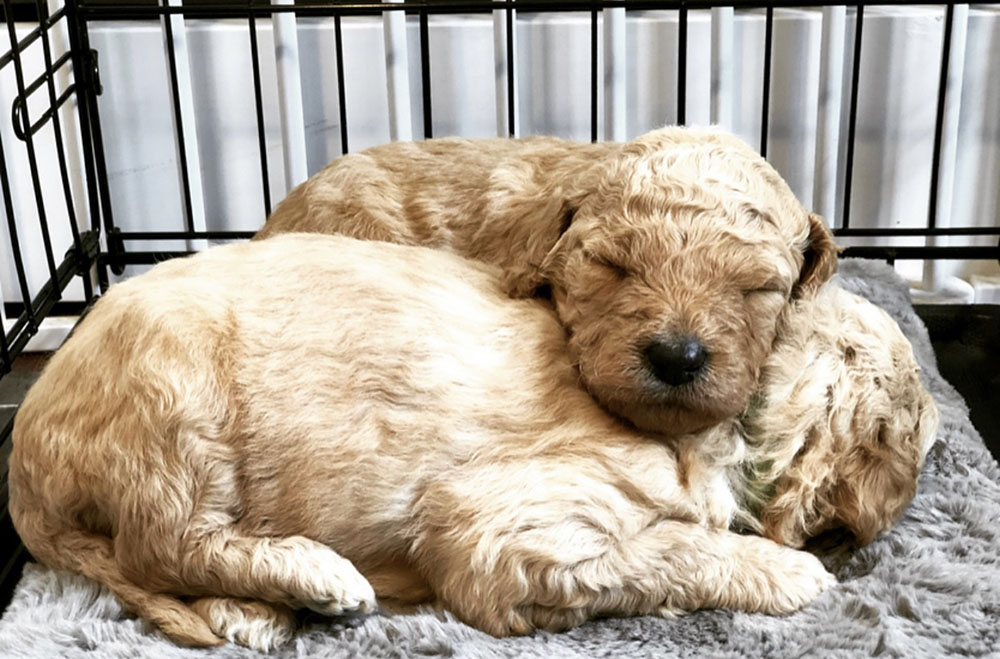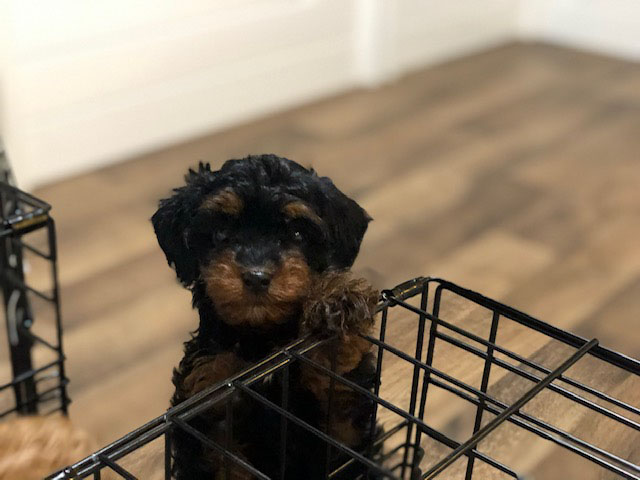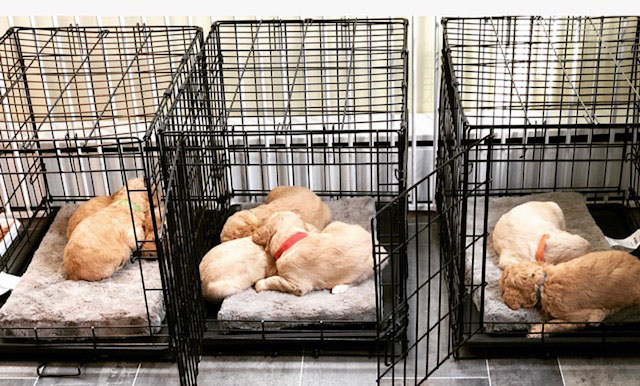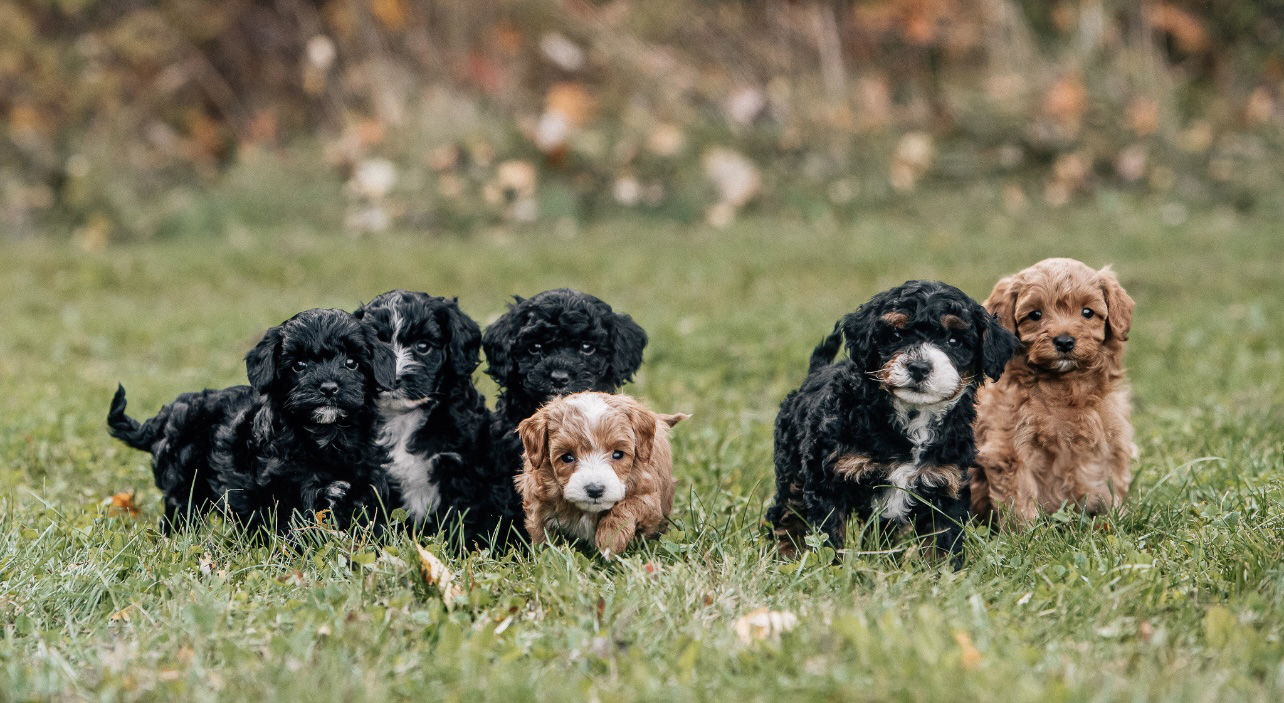Read Time: 15 minutes
Table of Contents
- Quick Takeaways
- Let’s Talk About Crate Training
- Is Crate Training Cruel? Debunking the Myths
- Your Puppy’s Natural Love for Cozy Spaces
- The Amazing Benefits You’ll Both Love
- Myth vs. Reality: What Crate Training Really Looks Like
- When Should You Start Crate Training?
- What the Experts Say
- Common Crate Training Mistakes to Avoid
- Your Questions Answered
- Ready to Start Your Journey?
Quick Takeaways: Why Crate Training Matters
Three Essential Reasons Every Puppy Parent Should Know:
- Necessary Life Skills – Your dog will need to be crated at the vet, groomer, and during travel. Crate training prevents stress and anxiety during these unavoidable situations.
- Faster House Training – Puppies naturally avoid soiling their sleeping area. A properly-sized crate can cut house training time in half.
- Safe Space for Your Puppy – Dogs are natural den animals. A crate becomes their secure retreat where they can rest undisturbed, especially important during the adjustment to a new home.
Let’s Talk About Crate Training
Here’s something that might surprise you: before you even met your adorable CavaDoodle, mini Goldendoodle, or Cavapoo puppy, we’d already started their crate training journey here at Maple Hill Doodles in Northeast Ohio!
I know what you might be thinking. A crate? Really? Doesn’t that seem a bit… confining?
Trust me, I get it. When I first learned about puppy crate training years ago, I had the same concerns. But here’s what changed my mind completely: watching puppies naturally gravitate toward their crates, choosing them as their favorite nap spots, and seeing how much calmer and happier they were with their own special space.
Think of it this way: we all need our own cozy corner where we can relax and recharge, right? Your puppy is no different! When you set it up right and continue the positive training we’ve started, their crate can become a safe space they accept and feel comfortable in.
At Maple Hill Doodles, located just 45 minutes from Cleveland, we’ve incorporated crate training as part of our comprehensive Early Neurological Stimulation (ENS) program, and the results speak for themselves. Our puppies learn early on that crates equal comfort, safety, and love.

Is Crate Training Cruel? Let’s Clear This Up
Okay, let’s tackle the elephant in the room right away. This is probably the biggest worry new puppy parents have, and honestly? It’s completely understandable.
No, crate training is absolutely not inhumane when you use it the right way! And that’s the key phrase here: when you use it the right way.
Think about it like this: Do you consider your bedroom a prison? Of course not! It’s your sanctuary, your personal space where you feel most comfortable. That’s exactly what a crate becomes for your doodle puppy.
The American Kennel Club and pretty much every veterinarian and dog trainer out there agree: crate training is one of the most humane, effective, and beneficial things you can do for your puppy. It’s not about locking them up. It’s about giving them their own safe haven in a sometimes overwhelming world.
Setting Realistic Expectations
Here’s where we need to be honest with you. While we’ll help you understand the right way to use a crate, it’s important to know what to actually expect:
Some dogs grow to love their crates. They’ll voluntarily choose their crate as their preferred nap spot, even when they have full house freedom. It becomes their favorite place.
Other dogs simply accept their crates. They’re perfectly happy napping on the sofa or wherever happens to be near their human. They tolerate the crate calmly when needed, but don’t seek it out.
Both outcomes are perfectly fine! The goal isn’t for your puppy to love their crate. The goal is for them to accept it calmly and feel secure in it. Why does this matter so much? Because there will be times in your dog’s life when crate time isn’t optional: at the vet’s office, at the groomer’s, or when flying in-cabin. If your dog isn’t crate trained, these necessary situations can cause serious distress. But a crate-trained dog? They handle these moments with calm confidence.
The Right Way vs. The Wrong Way
The right way means:
- A cozy space your puppy chooses on their own
- Filled with comfy bedding and familiar scents
- Used for appropriate amounts of time
- Always associated with positive experiences
The wrong way (which we never, ever do):
- Leaving a puppy crated for too long
- Using it as punishment
- Forcing them in harshly
- Not making it comfortable
When you follow the positive approach (which we’ll help you with every step of the way), your puppy will learn to feel safe and comfortable in their crate.
Your Puppy’s Natural Love for Cozy Spaces
Here’s something really cool about dogs that might just blow your mind: they’re hardwired to love small, enclosed spaces. It’s in their DNA!
The Den Instinct Explained
Your adorable doodle puppy comes from a long line of ancestors (wolves, foxes, and wild canines) who all relied on dens for survival. These weren’t prisons; they were lifesavers that provided:
- Protection from harsh weather and scary stuff
- Comfort when feeling vulnerable or tired
- A safe spot to raise babies and recover from injuries
- Peace and quiet when the world got too overwhelming
Your puppy still has these same instincts! Even though they’re living in your comfy home instead of the wild, that desire for a cozy, secure den hasn’t gone anywhere.
What Happens Without a Crate?
Without a proper crate, your clever puppy will find their own “den” space. They might choose under your bed, behind the couch, in your closet, or behind furniture. These spots can be hard to access when you need them for meals, potty breaks, or bedtime routines.
Making the Perfect Den for Your Puppy
When you provide a crate, you’re not imposing something weird on your puppy. You’re actually giving them exactly what their instincts are screaming for! It’s like… imagine if someone offered you a private suite at a fancy hotel. Would you turn it down? Probably not!
Important note: Your puppy’s crate is their personal space. This means when they’re in their crate, they should be able to rest undisturbed. Teach children and visitors that when the puppy is in their crate, we leave them alone. No poking fingers through the bars, no trying to play with them. This helps your puppy see their crate as a true safe zone where they can relax without interruption.
And here’s where our preparation helps: every puppy who leaves Maple Hill Doodles goes home with a special blanket that smells like their mama. This familiar scent can help during those first few nights. However, it’s important to have realistic expectations. While our puppies do choose to sleep peacefully in their crates here with us, they often take a few steps back when they arrive at your home. Why? Because they’re babies, and everything is brand new and unfamiliar. There will likely be an adjustment period with some sleepless nights while your puppy vocalizes their unhappiness about the changes. This is completely normal! With patience and consistency in continuing the positive training we’ve started, they’ll settle in.
We also totally recommend adding a Snuggle Puppy from our supplies list to your pup’s crate. This magical little thing has a heartbeat and warmth, mimicking the feeling of snuggling with littermates. It’s like having a tiny security blanket that breathes!
The Amazing Benefits You’ll Both Love
Now that we’ve addressed the concerns, let’s talk about all the wonderful ways crate training is going to make your life (and your puppy’s life) so much easier and happier.
House Training Becomes SO Much Easier
Let’s be real: nobody loves cleaning up puppy accidents at 2 AM. And guess what? Your puppy doesn’t love having accidents either! Dogs naturally want to keep their sleeping area clean. It’s just how they’re wired.
When your puppy is in an appropriately sized crate, they’ll instinctively hold their bladder until you let them out. This means way fewer accidents around your house, your puppy learns bladder control faster, you can predict bathroom times more easily, and everyone gets more sleep at night. The Humane Society says crate training can cut house training time in half!
One super important thing though: You can’t leave a puppy in a crate longer than they can physically hold it. Young puppies need potty breaks every 2 to 3 hours during the day. Think of it like a toddler: they’re doing their best, but biology is biology! Want the complete scoop on potty training schedules and techniques? We’ve got you covered with our detailed puppy house training guide.
Car Rides Become Safe and Stress-Free
Picture this: You’re driving down the highway, and your excitable puppy suddenly decides your lap looks more comfortable than the back seat. Or they spot a squirrel and try to climb out the window. Scary, right?
Just like babies need car seats, puppies need safe restraint during travel. And a crate is the gold standard!
The awesome benefits:
- Your puppy can’t get hurt in sudden stops or (heaven forbid) accidents
- They can’t distract you while you’re driving
- They actually feel calmer in their familiar “den” during trips
- You can crack windows without worrying about escape attempts
- They have room to stand, stretch, or curl up for a nap
Long road trip ahead? Your puppy can rest peacefully in their cozy crate while you focus on the road.
One critical warning: NEVER leave your puppy in a crated car when it’s warm outside. Car temperatures can become deadly in under five minutes, even with windows cracked. Your pup’s safety always comes first!
Everyone Sleeps Better at Night
Remember those first few nights with a new baby? (Or maybe you’ve heard the horror stories?) Well, puppies can be similar, except they can also get into mischief while you’re sleeping!
With a crate, your puppy has a designated quiet space for rest, develops a healthy sleep routine over time, stays secure while you sleep, and will eventually settle more peacefully with your consistent training. Puppies sleep a lot and need frequent naps throughout the day. The crate provides a consistent, quiet spot for all that important rest.
Socialization Actually Gets Easier
Okay, this one seems backward at first. How does putting a puppy in a crate help with socialization? Let me explain!
When your puppy first comes home, everything is new and exciting. They want to meet everyone, jump on everyone, lick everyone’s face, and generally be the center of attention. And while that’s adorable, not everyone is ready for the full puppy experience on day one.
The crate helps with:
- Controlled introductions to new people
- Teaching patience and impulse control (life skills!)
- Keeping enthusiastic puppies from overwhelming nervous guests
- Letting your puppy observe social situations safely
- Preventing jumping habits before they start
Here’s a perfect example: Your neighbor stops by, the one who’s allergic to dogs or maybe a bit nervous around puppies. Instead of your pup launching themselves at your guest, they can hang out in their crate in the same room. They get to see you, hear conversations, smell new people, and learn that visitors are normal and no big deal.
After the visit, you let your puppy out for a potty break and some loving. They learn: “When I’m patient and calm, good things happen!” That’s the foundation for a lifetime of good manners.
Boundaries Become Clear and Stress-Free
Puppies are basically tiny, furry toddlers with even less impulse control. They want to be with you ALL the time, which is sweet but not always practical or healthy!
The crate teaches your puppy that being alone for short periods is totally okay, not every room in the house is puppy territory, you’ll always come back (this prevents separation anxiety!), and independence is a good thing.
Here’s a gentle training tip: Instead of constantly saying “No! Get out of there!” when your puppy wanders into an off limits room, you can use the crate as a teaching tool. Let them explore the room briefly while you pretend to be busy. Then gently guide them out, pop them in their crate with a treat, and let them watch you return to that room. Keep your visits short at first. You don’t want to create anxiety. When you come back out, release your puppy with lots of love and praise. They’re learning boundaries without any stress or negativity!
For detailed step-by-step training techniques and troubleshooting tips, check out our upcoming how to crate train your puppy guide.
Vet Visits, Grooming, and Travel Become Less Stressful
Here’s something many new puppy parents don’t think about: there will be times when your dog absolutely must be in a crate, whether they like it or not. At the veterinarian’s office, at the groomer’s, when flying in-cabin, or during boarding, crates aren’t optional in these situations.
A crate-trained dog:
- Stays calmer during vet hospital stays and examinations
- Handles grooming appointments without panic
- Travels by plane or car safely and comfortably
- Recovers more peacefully after surgery
- Makes boarding experiences less stressful
- Has the skills to cope when confinement is necessary
An untrained dog? These same situations can cause stress and anxiety.
According to the American Veterinary Medical Association, dogs familiar with crates show measurably lower stress levels during medical procedures. The difference can be significant, think of it as the difference between someone who’s comfortable in hospitals versus someone who’s never been and is now facing surgery.
Your Puppy Has a Safe Space During Busy Moments
Puppies are naturally curious and explore everything with their mouths. This is completely normal and important for their development.
The crate provides security when you’re bringing in groceries or answering the door, you’re cooking or doing household tasks, workers or visitors are coming and going, or you need a moment to focus without supervising. Having a safe spot for your puppy during these busy moments gives you peace of mind. You can handle what you need to do, and your puppy can relax in their familiar space.

When Should You Start Crate Training?
Great question! The short answer is: as early as possible!
Our Head Start at Maple Hill Doodles
Here at Maple Hill Doodles, we start introducing puppies to crate training when they’re between 4-6 weeks old. By the time your puppy comes home with you, they’ve had positive experiences with crates here in our home. However, expect an adjustment period when they arrive at your house. Everything is new, unfamiliar, and sometimes scary for a young puppy. The crate training will need to continue with patience and consistency.
The Magic Window: 3-14 Weeks
Puppies have what behaviorists call a “critical socialization period” between 3-14 weeks of age. During this time, they’re like little sponges, soaking up experiences and forming opinions about the world. Start crate training during this window, and your puppy will likely accept it as just “how things are.”
Your timeline looks like this:
- 3-6 weeks: We introduce crates at our facility (check!)
- 8-12 weeks: You continue the training at home with patience for the adjustment period
- 3-6 months: Gradually extend crate time as appropriate
- 6+ months: Your puppy handles their crate with calm acceptance
When you bring home a Maple Hill Doodles puppy, we’ve already laid the foundation. You’re building on what they’ve learned, though they will need time to adjust to their new environment. Want to learn more about how we prepare your puppy? Visit our adoption process page.
What If My Dog Is Older?
Don’t worry! While this article focuses on puppies, older dogs absolutely can learn to love crates too. It just takes a bit more patience and a slower approach. The same positive principles apply. Just expect a longer adjustment period and celebrate every small victory!
What the Experts Say
You don’t have to take just my word for it. Pretty much every dog professional out there is team crate training!
The Professional Consensus
The American Kennel Club explains that crate training “takes advantage of your dog’s natural instincts as a den animal” and provides lifelong benefits for both dogs and their humans.
The Humane Society of the United States calls it “one of the quickest and most efficient ways to house train a dog” while highlighting its many additional perks for safety and management.
Veterinary behaviorists consistently emphasize that proper crate training actually reduces anxiety in dogs by giving them a secure retreat, especially important in busy households or during stressful situations.
The Power of Positive Training
Modern dog training is all about positive reinforcement: rewarding the behaviors you want instead of punishing what you don’t want. Crate training fits this approach perfectly!
According to the experts at Whole Dog Journal, successful crate training requires:
- Making it voluntary: Encourage, never force
- Creating positive vibes: Treats, toys, comfort, and praise
- Going at your puppy’s pace: No rushing or pressure
- Being consistent: Routines make puppies feel secure
- Having patience: Every puppy is unique and learns differently
The golden rule: NEVER use the crate for punishment. Ever. Not even once. The crate has to remain a happy place, or the whole thing falls apart. Using it as a timeout spot destroys everything you’re building.
Think of it like this: You wouldn’t want your bedroom to become associated with punishment, right? Same deal for your puppy and their crate!
Common Crate Training Mistakes to Avoid
Even with the best intentions, it’s easy to make mistakes that can slow down progress or create negative associations. Here are the most common pitfalls we see:
1. Using the Crate as Punishment
The Mistake: Putting your puppy in the crate when they’ve misbehaved or using it as a “timeout.”
Why It’s a Problem: This creates a negative association with the crate. Your puppy should see their crate as a safe, happy place, not where they go when they’re in trouble.
The Fix: Only use the crate for rest, meals, or short periods when you can’t supervise. Always make it positive!
2. Choosing the Wrong Size Crate
The Mistake: Getting a crate that’s too large (thinking ahead to adult size) or too small (uncomfortable for the puppy).
Why It’s a Problem: Too large, and your puppy may use one corner as a bathroom. Too small, and they can’t stand, turn around, or lie down comfortably.
The Fix: Get a crate with an adjustable divider that grows with your puppy, or size appropriately for their current size.
3. Leaving Them Crated Too Long
The Mistake: Exceeding your puppy’s ability to hold their bladder or leaving them crated all day and all night.
Why It’s a Problem: This causes accidents in the crate, anxiety, and can create negative associations. Puppies need frequent bathroom breaks, exercise, and social interaction.
The Fix: Follow the one hour per month of age rule (plus one hour). A 3-month-old puppy should not be crated more than 4 hours maximum.
4. Not Making It Comfortable
The Mistake: Bare crate with no bedding, blankets, or comfort items.
Why It’s a Problem: Would you want to sleep on a hard plastic floor? Neither does your puppy!
The Fix: Add comfortable bedding, the mama-scented blanket, a Snuggle Puppy, and safe toys. Make it cozy!
5. Expecting Instant Success
The Mistake: Thinking the puppy will transition perfectly on day one because they were crate trained at the breeder’s.
Why It’s a Problem: Puppies often regress when moving to a new home. Everything is unfamiliar, and they need time to adjust.
The Fix: Have realistic expectations. Prepare for some sleepless nights and vocalization. Be patient and consistent with training.
6. Giving In to Crying Too Quickly
The Mistake: Immediately letting the puppy out every time they whimper or cry.
Why It’s a Problem: This teaches them that crying gets them released, which reinforces the behavior.
The Fix: Determine if it’s a real need (bathroom, water) or protest. If protest, wait for a quiet moment before rewarding with release.
7. Only Using the Crate When Leaving
The Mistake: Only crating your puppy right before you leave the house.
Why It’s a Problem: The puppy learns that crate = you’re leaving, which can increase separation anxiety.
The Fix: Use the crate at various times throughout the day, even when you’re home. Feed meals in the crate, give special treats, and let them rest while you’re nearby.

Your Questions Answered
Let’s tackle some of the most common questions we hear from new puppy parents. Don’t worry, these are questions everyone has!
Is crate training really necessary for my puppy?
Okay, so technically it’s not legally required (your puppy police won’t come knocking!). But here’s the thing: veterinarians and professional trainers recommend it for really good reasons. It makes house training SO much faster, keeps your puppy safe during travel, gives you options for managing situations, and provides your puppy with their own secure space.
Think of it this way. It’s not necessary like food and water, but it’s necessary like having a car seat for your baby. You could technically get by without it, but why would you want to?
How long can I leave my puppy in a crate?
This is super important, so I’m glad you asked! The general rule of thumb is: one hour per month of age, plus one hour. So a three-month-old puppy shouldn’t be crated for more than four hours.
But here’s the real talk: that’s the maximum, not the goal. Shorter is always better when possible! Adult dogs shouldn’t exceed 6-8 hours, and even then, this should be rare, not routine.
Remember: your puppy isn’t just physically uncomfortable after too long. They’re probably lonely and bored too. Nobody wants that!
What size crate should I get for my doodle puppy?
Your puppy should be able to stand all the way up, do a full turn-around, and lie down stretched out comfortably. But you also don’t want a crate that’s too big, or your clever puppy might decide one corner is for sleeping and another corner is for… well, you know.
For growing doodles (and oh boy, do they grow!), I love crates with adjustable dividers. You can expand the space as your puppy grows, which means you’re not buying multiple crates. Smart and budget-friendly!
Check out our puppy supplies list for size recommendations specific to CavaDoodles, mini Goldendoodles, and Cavapoos.
Will crate training prevent separation anxiety?
When done right, absolutely! Crate training teaches your puppy that being alone temporarily is normal, safe, and no big deal. It’s an essential life skill.
BUT (and this is important) improper use can actually contribute to anxiety. Like if you only use the crate right before leaving for work, or if you leave them crated for too long, that can create negative associations.
The key is balance: use the crate at various times (not just when you leave), keep durations appropriate, make it super positive, and ensure your puppy gets plenty of interaction, play, and exercise when they’re out.
Should I keep the crate in my bedroom or another room?
For young puppies, keeping the crate in your bedroom is usually best! Here’s why:
- They don’t feel isolated and scared
- You can hear when they need midnight potty breaks
- It helps prevent anxiety during those first few weeks
- They learn to sleep through normal nighttime sounds
Many people successfully move the crate to another location once their puppy is older and has better bladder control. There’s no one “right” answer, just whatever works for your family and keeps your puppy feeling secure!
What should I put inside the crate?
Great question! Here’s the perfect setup:
- Comfortable bedding (soft and cozy!)
- The mama-scented blanket we send home with your puppy
- A Snuggle Puppy for warmth and that comforting heartbeat
- Safe toys if your puppy won’t chew and swallow pieces
What NOT to include:
- Food and water during long stays (can cause accidents)
- Collars or harnesses (catching hazards)
- Anything destructible that could be swallowed
My puppy cries in the crate. What should I do?
Some crying at first is totally normal. Everything’s new, and your puppy is adjusting! The trick is figuring out whether they’re crying because they need something (bathroom, thirst, discomfort) or just protesting.
If they need something: Respond immediately! Let them out for a quick bathroom break, then back in the crate.
If it’s just protest crying: Wait for even a moment of quiet, then reward that silence with calm praise. If you release them while they’re crying, you’re accidentally teaching them that crying = freedom.
It’s hard to resist those puppy whimpers, I know! But consistency here really pays off.
Can I use the crate for discipline or punishment?
NO! Never, ever, not even once! This is the fastest way to ruin all the positive associations you’re building.
Your puppy should think: “Crate = cozy, safe, happy place where good things happen!”
NOT: “Crate = where I go when I’m in trouble.”
If you need to correct behavior, use appropriate training techniques that have nothing to do with the crate. The crate must remain Switzerland, completely neutral or positive, always.
How do I eventually give my puppy freedom in the house?
Great question! This should be gradual, like, really gradual. Here’s the progression:
- Leave the crate door open during supervised time
- Use baby gates to expand to one small area
- Gradually increase space as your puppy proves reliable
- Eventually (maybe!) give full house access
Here’s something to keep in mind: some dogs do grow to love their crate and voluntarily use it for naps throughout their lives, even with complete house freedom. Others prefer the couch, your bed, or wherever you’re sitting. Both are perfectly normal!
The important thing is that your dog feels comfortable and safe in their crate when they need to be in one, which will happen at the vet, groomer, during travel, and other situations where crating isn’t optional. That’s the real win!
Ready to Start Your Journey?
At Maple Hill Doodles, located in beautiful Northeast Ohio just a short drive from Cleveland, we’re not just about breeding adorable puppies (though they are pretty darn cute!). We’re about setting up both you and your new family member for a lifetime of happiness and success.
The Maple Hill Advantage
Every puppy who leaves our care has already experienced:
- Early crate introduction starting at 4-6 weeks
- Positive associations built through comfort and patience
- Mama-scented blanket to help with transitions
- Our ENS program benefits creating confident, adaptable puppies
- Foundation training that you’ll continue building on at home
When your doodle puppy comes home, they’ve had positive crate experiences with us. You’ll be continuing this training through the adjustment period as they settle into their new environment.
Choosing Your Perfect Puppy
The temperament and early experiences of your puppy make a HUGE difference in training success. That’s why choosing a responsible, caring breeder matters so much.
Not sure what to look for? Our guide to finding the best breeder walks you through exactly what questions to ask and what red flags to avoid.
At Maple Hill Doodles, we take the time to match puppies with families based on temperament, lifestyle, and what you’re looking for in a companion. Whether your heart is set on our available CavaDoodles, mini Goldendoodles, or Cavapoos, we’re here to help you find your perfect match!
Keep Learning and Growing Together
Crate training is just the beginning of your amazing journey together! Continue building your puppy knowledge with these resources:
Related Articles:
- How to Crate Train Your Puppy: Step-by-step techniques and solutions to common challenges
- Complete House Training Guide: Schedules, tips, and how to prevent accidents
- Finding the Best Breeder: What to look for and questions to ask when choosing a responsible breeder
- Early Neurological Stimulation (ENS) Program: How we prepare your puppy from day one for a lifetime of confidence
Getting prepared:
- Puppy Supplies List: Everything you’ll need before bringing your puppy home
- Adoption Process: What to expect when you’re expecting… a puppy!
Let’s Make This Happen!
Ready to experience the absolute joy of raising a well-prepared, healthy, happy doodle puppy? We’d genuinely love to be part of your journey!
Our puppies are raised with so much love, attention, and early preparation, including the crate training foundation. We’re here to support you from application day through your puppy’s entire life (and we mean that, we’re always just a message away!).
Start your puppy application today and take that exciting first step toward welcoming a Maple Hill Doodles puppy into your family. Trust me, it’s going to be an amazing adventure!
One Last Thing…
Crate training really is one of the best gifts you can give your puppy. I know it might feel weird at first. Believe me, I’ve been there! But the goal isn’t to make your dog obsessed with their crate. The goal is much more practical: to help them feel safe and comfortable when they need to be in one.
Some dogs do end up loving their crates and choosing them for voluntary naps throughout their lives. Others prefer the couch, your bed, or wherever you happen to be sitting. Both outcomes are perfectly fine! What matters is that when your dog needs to be crated (at the vet, groomer, when traveling, or during emergencies), they handle it calmly instead of with fear and panic.
Throughout your dog’s life, that crate training pays dividends in reduced stress during necessary confinement. A crate-trained dog can travel safely, recover peacefully after medical procedures, and handle unexpected situations without falling apart. An untrained dog? These same situations can be traumatic for both of you.
At Maple Hill Doodles, we’ve watched thousands of puppies benefit from positive crate training. Those few weeks of initial training create a skillset that protects your dog’s wellbeing for their entire life.
Remember: patience, consistency, and keeping everything positive are your superpowers here. Never rush it, never use the crate as punishment, and always celebrate the small victories. The goal is acceptance and comfort, not necessarily love, and that’s completely okay!
Your puppy’s journey to becoming a confident, happy, well-adjusted family member starts with these early foundations. We’re honored to be part of it with you, and we can’t wait to see how your story unfolds!
Ready to meet your new best friend? Complete your application or check out our available puppies today. Your perfect doodle is waiting!



